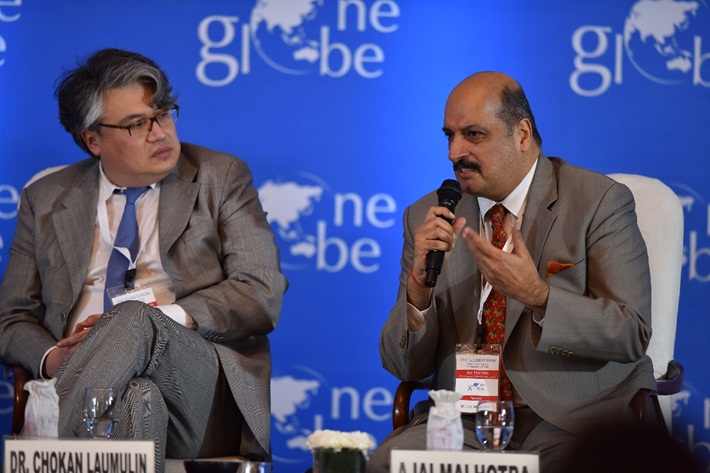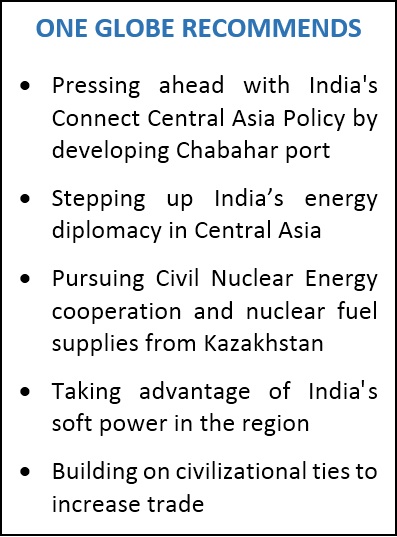India and Eurasia: Linkages to the Silk Road
Posted by Admin on December 14, 2017

Mr. Chokan Laumulin, Researcher at University of Cambridge, with Mr. Ajai Malhotra, former Ambassador of India to Russia
 |
India must forge ahead with developing the strategic port of Chabahar in Iran and the three-nation pact to build a transport-and-trade corridor through Afghanistan that could help halve the time and cost of doing business with Central Asia and Europe. “Developing Chabahar port is also strategically important as it outflanks the China-Pakistan economic corridor project with Gwadar as its focal point,” said Ajai Malhotra, former Ambassador of India to Russia, in a panel titled “India and Eurasia: Linkages to the Silk Road” at the One Globe Forum held in Delhi in February 2017.
Prime Minister Narendra Modi signed the Chabahar agreement with Iran, resurrecting India’s Connect Central Asia Policy by opening up new trade routes, bypassing Pakistan. “The strategic mistrust between Delhi and Beijing makes it difficult for Indian policymakers to accept China’s “One Belt, One Road” or Silk Road Economic Belt initiative,” pointed out Mr Malhotra.
To keep from being boxed in by China and Pakistan, Mr Malhotra said, India would like to use the North-South Transport Corridor stretching from ports in India to the port of Chabahar in Iran, to access Afghanistan, which has a highway across the north linking to Central Asia, culminating in Kazakhstan.
“It will reduce time and cost in sending goods to Kazakhstan on one side and Western Europe by 30 to 40 percent. Trial runs have been initiated and we should support it,” pointed out Mr Malhotra. “India has strong traditional ties with Central Asia, but we need to find new areas of cooperation.”
Fellow panelist, Louis Skyner, Head of Russia & CIS Oil & Gas at Clifford Chance, cited the potential for greater energy cooperation in the region. He described his experience working on the liquefied natural gas project in the Russian Arctic. Mr Skyner talked about how the technologically challenging project which brought in gas from the arctic cold was made possible by the Silk Road Fund.
“I have seen that where you have a system of financing where you allocate risks and responsibilities clearly, you will attract investment,” said Mr Skyner, whose practice includes more than ten years of work in the oil and gas sector. “One of the challenges India faces is creating a framework which will give both investors and financial institutions the confidence that projects here are bankable,” added Mr Skyner.
Panel moderator Dr Sidharth Saxena, Chairman, of the Cambridge Central Asia Forum, asked how India could play a bigger role in Eurasia. Chokan Laumulin, PhD Researcher, Darwin College, University of Cambridge, confirmed that, for India, Central Asia has “assumed significance,” not merely as an “extended neighbour with ancient civilizational links,” but because of “huge economic, security and energy advantages.”
Mr. Laumulin and the other panelists agreed that India’s energy diplomacy in Central Asia would define the new relationship. “Kazakhstan, the biggest oil and gas producer in Central Asia, has advocated for an Asian Energy Strategy,” said Mr Laumulin. He noted that Turkmenistan has agreed to enhance the ambit of energy cooperation and is seeking the expertise of Indian oil and gas PSUs in the fields of training, design, construction, exploration and production. Central Asian states are rich in energy resources. “Kazakhstan, the world’s largest producer of uranium, is one of the few countries which took the bold step of providing India with nuclear fuel,” pointed out Dr Saxena. In July 2015, India inked an agreement with Kazakhstan to supply India with 5,000 metric tons of nuclear fuel by 2019. The uranium supply from Kazakhstan is a boon to India’s energy plans.
“If the zero was invented in India, algebra was invented by the famous mathematician Al-Khwarizmi in Khiv, also a key city on the Silk Road like Bukhara. There’s so much India can do with Central Asia in energy research,” said Mr Laumulin.
Fellow panelist and Carnegie India Director C Raja Mohan looked at India’s relationship with Eurasia through the arc of history and said India was cut off from Central Asia following the Partition of British India. “After Independence, India turned inward, made self-reliance a leitmotif. It’s only with the 1991 free-market reforms that you are seeing outward engagement,” said Dr Mohan. He said India has to find a modus vivendi with regional rivals China and Pakistan; “India has to find ways of transcending problems with China and Pakistan because without that you are going to be boxed in.”
Dr Mohan summed up by saying, “We have to go beyond our obsession with land connectivity. We have to build on our relationship through air connectivity, business connectivity, partnerships in science and technology. India’s soft power is evident in Central Asia countries where Bollywood movies and Hindi songs are so popular. We need to exploit these cultural connections.”








